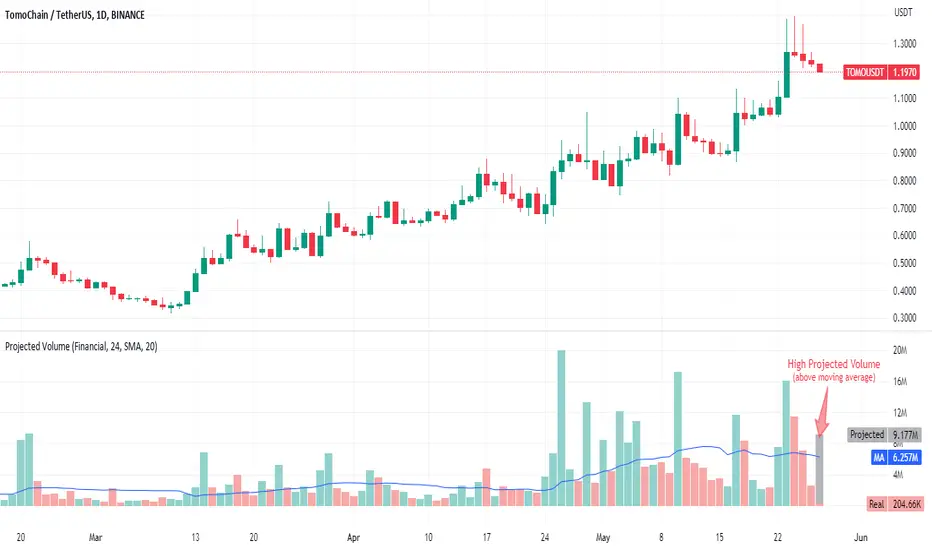OPEN-SOURCE SCRIPT
Projected Volume
Updated

Overview
The indicator displays the expected volume up to the closing time of the session.
Calculations
The real volume is proportional to the projected volume, just as elapsed session time is proportional to entire trading session. Knowing the actual volume, the elapsed time of the session and the total time of the trading session, it is possible to find out the projected volume.
How It Works
On the last volume bar, the indicator shows the projected volume overlapped with the real volume.
How To Use
Assuming that any price movement is of little relevance if not confirmed with considerable volume, if a strong signal appears on the intraday chart but with low volume, we can overlook it as the projected volume on the daily chart is high and indicates that there is a high chance of directional movement for the day. In short, even if we have an entry signal with low volume on the intraday chart, it will still be viable to open a trade as long as on the daily chart the projected volume is high, i.e, above the moving average.
Inputs
Use 24 hours in Trading Hours input for nonstop markets, like crypto and forex, or set the specific trading hours for other market types like stocks. The projected volume will be displayed on all timeframes if the value is equal to 24. For other values it will be displayed on the 1-day chart only.
The indicator displays the expected volume up to the closing time of the session.
Calculations
The real volume is proportional to the projected volume, just as elapsed session time is proportional to entire trading session. Knowing the actual volume, the elapsed time of the session and the total time of the trading session, it is possible to find out the projected volume.
How It Works
On the last volume bar, the indicator shows the projected volume overlapped with the real volume.
How To Use
Assuming that any price movement is of little relevance if not confirmed with considerable volume, if a strong signal appears on the intraday chart but with low volume, we can overlook it as the projected volume on the daily chart is high and indicates that there is a high chance of directional movement for the day. In short, even if we have an entry signal with low volume on the intraday chart, it will still be viable to open a trade as long as on the daily chart the projected volume is high, i.e, above the moving average.
Inputs
Use 24 hours in Trading Hours input for nonstop markets, like crypto and forex, or set the specific trading hours for other market types like stocks. The projected volume will be displayed on all timeframes if the value is equal to 24. For other values it will be displayed on the 1-day chart only.
Release Notes
The entire timeframe period will be considered to calculate the projected volume when using a timeframe different from 1-day.Open-source script
In true TradingView spirit, the author of this script has published it open-source, so traders can understand and verify it. Cheers to the author! You may use it for free, but reuse of this code in publication is governed by House rules. You can favorite it to use it on a chart.
Disclaimer
The information and publications are not meant to be, and do not constitute, financial, investment, trading, or other types of advice or recommendations supplied or endorsed by TradingView. Read more in the Terms of Use.